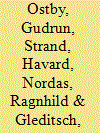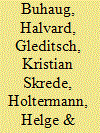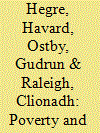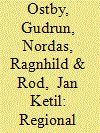|
|
|
Sort Order |
|
|
|
Items / Page
|
|
|
|
|
|
|
| Srl | Item |
| 1 |
ID:
126712


|
|
|
|
|
| Publication |
2013.
|
| Summary/Abstract |
Many studies report lower academic productivity among women. But are women less likely to get their research published in the first place? The evidence for potential gender bias in publication and impact is mixed. This article examines the gender dimension of scientific publication in international relations (IR) based on submission data for Journal of Peace Research for the period 1983-2008. It examines the gender gap in submissions and explores whether the perceived merit of a research paper is affected by the gender of the authors and reviewers. It also investigates whether the gender of the first author influences citation counts. The data show a clear but declining gender gap. They do not indicate any significant gender bias in publication success or citations.
|
|
|
|
|
|
|
|
|
|
|
|
|
|
|
|
| 2 |
ID:
107971


|
|
|
|
|
| Publication |
2011.
|
| Summary/Abstract |
Income varies considerably within countries and the locations where conflicts emerge are rarely typical or representative for states at large. Yet, most research on conflict has only examined national income averages and neglected spatial variation. The authors argue that civil conflicts are more likely to erupt in areas with low absolute income, even if a country's gross domestic product (GDP) per capita is not necessarily low, and in areas with large deviations from national averages. The authors test these hypotheses empirically using spatially disaggregated data on the location of conflict outbreaks and per capita income estimates. The authors find that areas with absolute poverty indeed see more outbreaks of conflict, and they find some evidence that inequality increases the risk of conflict. Subnational information can improve on conventional country-based measures and help our understanding of how local features and variation can give rise to mobilization and violence.
|
|
|
|
|
|
|
|
|
|
|
|
|
|
|
|
| 3 |
ID:
080982


|
|
|
|
|
| Publication |
2008.
|
| Summary/Abstract |
Recent large-N studies of civil war conclude that inequality does not increase the risk of violent conflict. This article argues that such conclusions may be premature because these studies, which usually test the conflict potential of `vertical inequality' (i.e. income inequality between individuals), tend to neglect the group aspect of inequality. Case studies suggest that what matters for conflict is a concept closely linked to both economic and ethnic polarization: `horizontal inequalities', or inequalities that coincide with identity-based cleavages. Horizontal inequalities may enhance both grievances and group cohesion among the relatively deprived and thus facilitate mobilization for conflict. This article provides a quantitative test of this argument, exploring whether various forms of polarization and horizontal inequalities affect the probability of civil conflict onset across 36 developing countries in the period 1986-2004. National household data from the Demographic and Health Surveys (DHS) are used to construct measures of ethnic, social and economic polarization, as well as vertical and horizontal inequalities along two dimensions: social and economic. The article also introduces a combined measure of ethnic/socio-economic polarization as an alternative to the horizontal inequality measure. Robust results from panel and cross-section analyses show that social polarization and horizontal social inequality are positively related to conflict outbreak. Variables for purely ethnic polarization, inter-individual inequalities and combined ethnic/socio-economic polarization are not significant.
|
|
|
|
|
|
|
|
|
|
|
|
|
|
|
|
| 4 |
ID:
091067


|
|
|
|
|
| Publication |
2009.
|
| Summary/Abstract |
This article examines the link between subnational poverty and the location of civil war events. Drawing on the ACLED dataset, which breaks internal conflicts down to individual events at the local level, we take a disaggregated approach to the study of conflict. Local-level socioeconomic data are taken from the Liberian Demographic and Health Survey. With geographical cells of approximately 76 km 2 as units of analysis, we test how absolute and relative welfare affect the presence and number of conflict events during the 1989-2002 Liberian civil war. We control for neighboring conflict events, distance to Monrovia and national borders, population density, diamond deposits, and ethnic affiliations. War events were more frequent in the richer locations. This may provide better support for "opportunity" explanations than for "relative deprivation" theories of conflict, but we argue that the relative weakness of the Liberian government makes it difficult to distinguish between the two.
|
|
|
|
|
|
|
|
|
|
|
|
|
|
|
|
| 5 |
ID:
089035


|
|
|
|
|
| Publication |
2009.
|
| Summary/Abstract |
The case study literature is ripe with examples of a positive association between inequality and civil war, but systematic country-level studies have largely failed to find a significant relationship. One reason for this discrepancy may be that large-N studies tend to ignore spatial variations in group welfare within countries, although civil wars often take place within limited areas. We address this gap in the literature by applying GIS operations to Demographic and Health Surveys to construct new disaggregated data on welfare and socioeconomic inequalities between and within subnational regions in 22 countries in Sub-Saharan Africa. These measures are coupled with geographical data on the location of conflict zones for the period 1986-2004. We find that conflict onsets are more likely in regions with (1) low levels of education; (2) strong relative deprivation regarding household assets; (3) strong intraregional inequalities; and (4) combined presence of natural resources and relative deprivation.
|
|
|
|
|
|
|
|
|
|
|
|
|
|
|
|
|
|
|
|
|